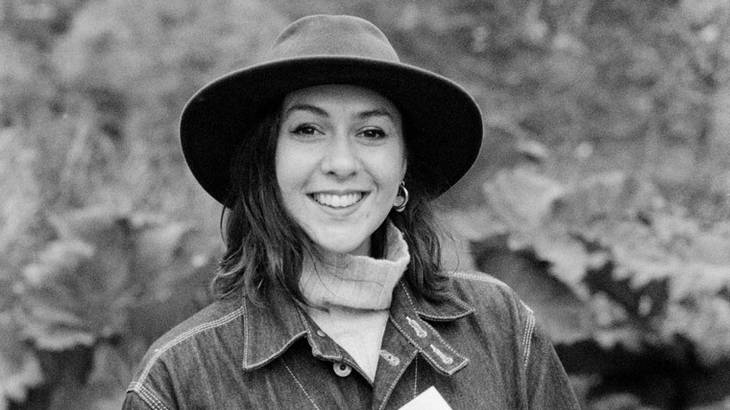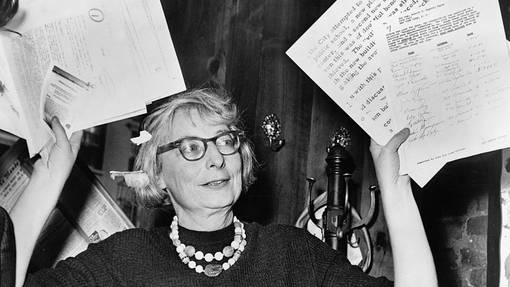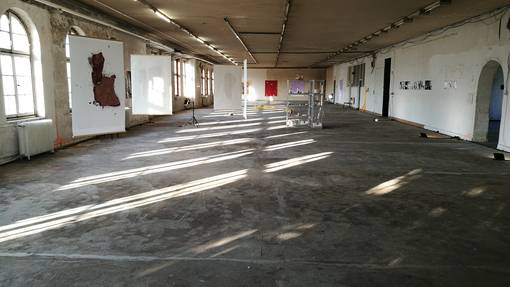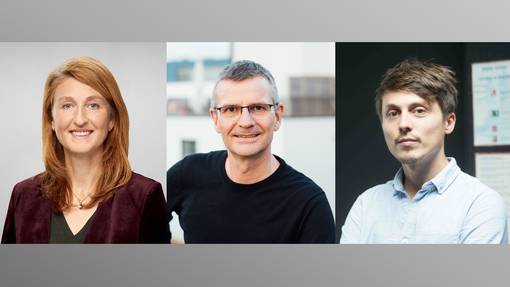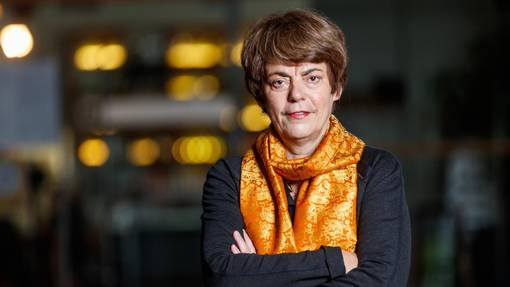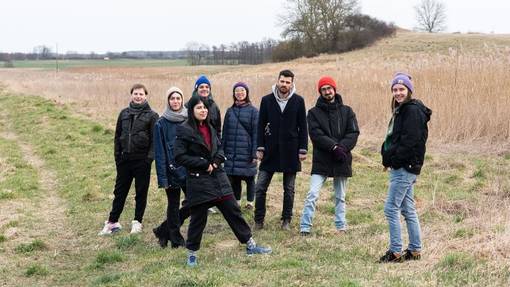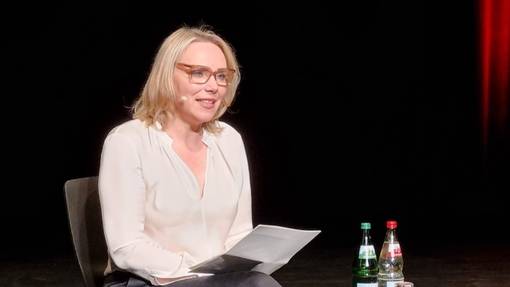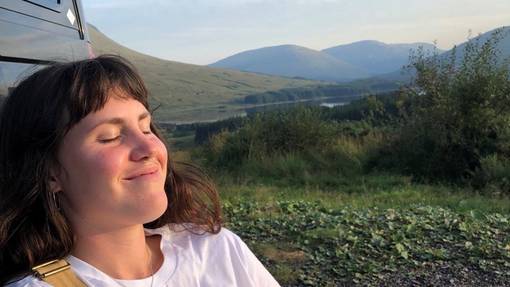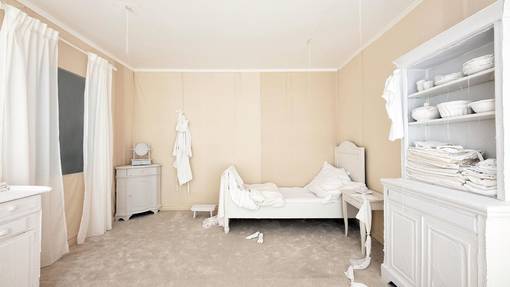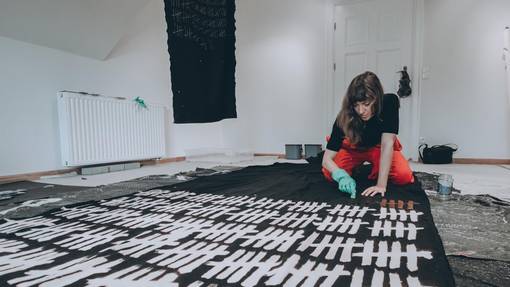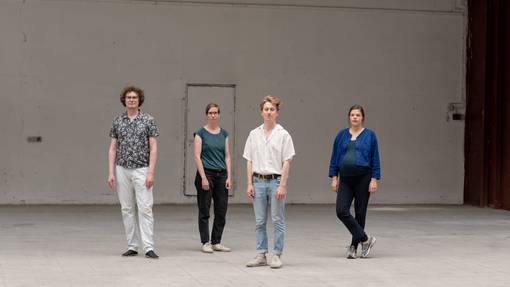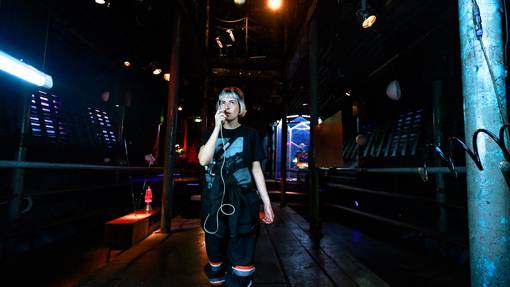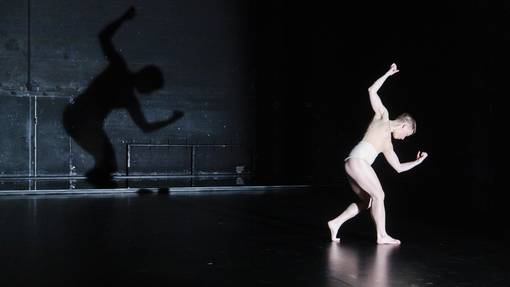Foraging Stories and Plant Phantoms. A Guided Ghost Walk Through Planten un Blomen
Lulu MacDonald, Bildende Künstlerin und stART.up-Stipendiatin
During a week in October 2021, scholarship holders of the artist programme stART.up created a transdisciplinary week (“Transdisziplinäre Austauschwoche”) filled with workshops, visits and lectures.
The week was structured so each day we would take part in workshops from one another and whilst getting to know each other we would also have the opportunity to learn about others’ practices, aspects to their thought process and take part in their concerns, musings and questions. For me, I wanted to structure a workshop which was as much a shared experience as it was a window into my own day to day ponderings. The 4 hour workshop aimed to create a metaphorical bouquet of stories. The park or any garden really is always created with a complete circle of life, with different botanical speeds. There are the ephemerals, annuals, biennials and perennials. The inevitability of life and death existing go hand in hand, but the idea of life after death, or dead things being sustenance for living things, or even being part of each other was something I wanted to share with my colleagues. I wanted each person to leave the workshop with a stronger connection to themselves and their surroundings, being able to pay attention to both micro ecosystems, as well as the macro ones. This practice of seeing both the nuance and the similarity in both scales is sculpturally something which interests me greatly. This scale-transformative-seeing is helpful in disarming thoughts to do with larger world problems like the climate crisis. Like today* as spring approaches and I re-read my words from the autumnal moon, making sense of our new reality, I can’t help but draw comparisons to my morning’s job of protecting my plants from the impending thunder storm in Hamburg, whilst Russia is bombing Ukraine.
* 25 March 2022
One grey October day in 2021, we gathered in the drizzle to begin a ghost walk through the graveyard/park which lies in the middle of Hamburg, Planten un Blomen.
We saw many things and we felt many things.
The Roots
About three years ago, I was commissioned for the first time to make a piece of work. I wanted to make a film where my grandma, Stella, read a story which I remember her telling me as a little girl. When she was a child, during the Second World War, her mother went out and bought Sweet Williams and daffodils with her last rations, instead of buying food. When her father returned home, he blew a gasket at the sight of the house covered in flowers. They sat at the table with nothing to eat, “but aren’t they beautiful…?” my great grandmother asked.
After reciting this memory back to my grandma and kindly asking her if she would be involved in the project my grandma laughed. “No, absolutely not!” she began. She had no idea what I was talking about. She made it clear that ration books didn't even cover flowers, that during the war there were no flowers because all of the garden space wouldn't be wasted on flowers but would have rather been used for vegetables so people could eat. She told me that I was remembering wrong, that I had it all wrong and that this fundamentally never happened.
I didn’t understand how and why this story had become so important to me. Every time I bought flowers which I couldn’t afford (which was most times) I would remind myself that it was an inherited habit – telling myself, “Oh Lulu, how charming…”
My grandma refused to tell the story as a voiceover for my project, because she said it was stupid to think anyone would buy flowers during the war. In that moment, I realised something much larger than the artwork I was grappling with; I realised that my grandma was traumatised. She was right, flowers probably are stupid. But since I was big enough to understand, I have watched my grandma mainly spending her time making her garden beautiful.
The Seed
My deepest childhood memories are ones of embedding myself intrinsically with nature in a spiritual way, I grew up on the channel island of Jersey, an island which is dotted with several Neolithic sites. I remember watching summer solstices through Neolithic graves or playing on dolmens with friends. The turbulent social and political identity of the island has long been of sculptural interest to me. On the west side of the island, there is a huge concrete wall which stretches the whole length of the beach. It was made by prisoners of wars under Nazi control when the island was occupied during World War II. I remember trailing my fingers on the surface of the concrete, and discovering tiny shells, or remnants of crabs. Only later using this material myself, did I realise that they must have used the wave beaten sand to build the concrete in the first place. As a survival method in dealing with my anxiety around the climate crisis, I often return to this idea of nature being intrinsically connected with ‘otherness’. Through non-human scales of time, frictions of coexisting realities and natural images which are so ingrained they have become almost totalitarian.
The Stem
After walking in silence through the half dead, half alive rose garden of Planten un Blomen, we arrived at the oldest tree in the park. He told us a sad story about how forests are dying. How once a forest could flourish in balance with animals, with people, with the water and the fungi. He told us of his cousins in Italy dying of a cancerous tumours created from pesticides which they were sprayed with. What once was a forest and is now agricultural fields are being washed down into the valley by intense rainstorms, ever wetter from the increased pressure in the atmosphere. The wise old tree invited my fellow wanderers to find a tree and hear their story.
We met a generous tree – who was also a little cheeky. He offered its sumptuous berries to birds and lowered his branches as the perfect place for children to play.
We met a queer tree – a beautiful intersex tree who was non-binary. They stood in a large crater in the park, allowing you to come in – only filled with acceptance and magic.
And finally, we met the bipolar tree, the tree with two very different sides, the side to the path – and the side hiding away.
We kept walking.
We reached my favourite plant in the park. The MEGAFAUNA.
The lake is surrounded by these gigantic plants. Long ago, the dinosaurs and prehistoric creatures who feasted on these plants are extinct. Why and how are these plants still thriving? Why after all this time do these plants continue to flourish when the animals that could feasibly feast on them are long extinct? Does it mean that they are going to return one day? Are these leaves the ghosts of the future?
The Soil
Then we came to the graveyard of last year’s autumnal leaves. They had been sitting here since last year. These huge mounds were burnt and left out in the sun over the summer in order to create this topsoil which is then distributed all over the park. This process is slow and lengthy. Every day, I bring my two children to nursery here, and every morning we take a look to see what is happening with the soil. The people who work in the park are like worker ants, always lifting and shifting, raking this or that, planting this, tending to that. Some machines and some hands are constantly in flow with the soil, with the leaves.
It was only in the last 10 years, that people have begun to imagine soil aesthetically in a different way. When I was at school, soil was just the layer of ground beneath my feet. The only thing I learnt about soil at school was about the importance of its existing as a fertile space in which to have further productivity. But alas, like all things, when you pay them some attention, we learn that the soil is alive. The most important organ of the ground. Like all backgrounds being moved to the forefront we realise they are not the site for human activity but they are in fact the activity.
Until now, Darwin’s observations have been widely accepted that soil is a space of minerals and chemical conditions, only ever speaking about it as something which had the perfect pH balance for growing vegetables or farming. A further space in the world where capitalism spreads its brutal and unforgiving expectations. Now though, when you read about scientists, or anthropologists, naturists and even gardeners, the soil is spoken about as a living being.
In soil, there are billions of bacteria and hundreds of microspecies, all filled with nutrients, aerating the ground. The concept of soil has changed, we have begun to think about the ground as also living. Lots of farmers, especially those who are farming in climates which are being mostly affected by the climate crisis have begun prioritising their fundamental farming by growing soil. It is an indigenous way of thinking, it is about healthy nurture, it is about care. We feed the soil, and the soil feeds us.
Perhaps it is because we are standing opposite the nursery where my children go, or maybe it is because I watch the process of the leaves turning to soil each time I say goodbye to my children - but this process and this place makes me think a lot about cycles. About slow deaths and about rebirthing. There is always this danger where one accepts the nature as just doing its job and that giving over to nature, giving over to the natural cycle of life and death is in some way fatalistic. And it is dangerous. To accept that the climate crisis is just part of a cycle means we can’t do anything, that nothing should be questioned, that our practices are anyway going to kill us. That maybe our kids or our grandkids might have a harder time, but by then we will be dead.
Instead, I believe not in the endurance for the future, not in what Darwin says, instead I believe in the nature of breaking down. This is not about making something stronger but building something up and breaking it back down - which is precisely what soil does. It is not fatalistic to learn how to live in a cycle, to practice continuous regrowth, to continuously practice repair, to constantly practice restoration.
Once we have restored the soils, we can restore the land. We can think about how the land is used and shared. We can think about the understory, the horrors, the boundaries, the terrible things we have done; we can give the land back. The soil has the potential to guide how to deal with the world in all its terrifying realities; to restore, to repair, to fix. We can begin to care about soils, and by doing that, we are caring for all of those that depend on it too. If the micro biological animals that live in the soil are part of the soil, then what are the creatures that live on top of it, that are buried into it and those that eat from it? If we imagine deep earth, deep soil as living, then perhaps we can equate soil with life itself.
And as Vandana Shiva, the environmental activist, said, without fertile soil what is life?
With thanks to research from: Martha MacDonald
Live performance: Simon MacDonald
Photography: Maik Gräf
Artikel kommentieren
Kommentare sind nach einer redaktionellen Prüfung öffentlich sichtbar.

